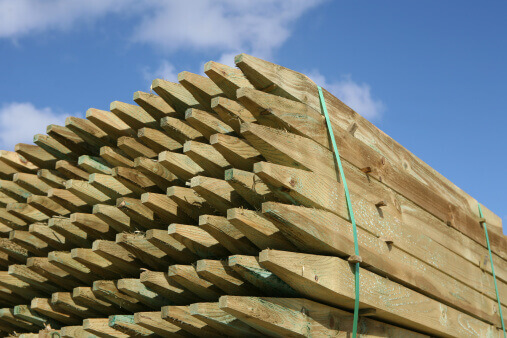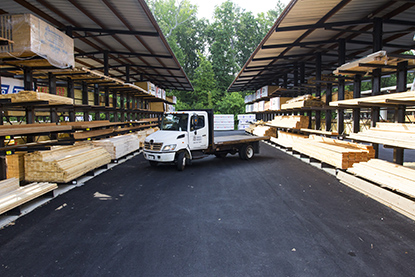There is a lot of information about pressure-treated wood out there. And unless you are a contractor, some of the details can be overwhelming. This is why we wanted to put together a list of the top three questions we get regarding pressure-treated lumber. If you are a homeowner or looking to do an outdoor project, this might be helpful. If you have any additional questions, our staff at Friel Lumber is happy to help. So, let’s get started.
What Does Pressure-Treated Mean?

Copper is the most widely used compound in wood preservatives and it gives the wood the green tint you see in this photo.
Lumber that is labeled as pressure-treated has gone through a method to force a solution of preservative agents into the wood. Through a high-pressure process, water and the preservatives are embedded into the lumber. This helps to extend the woods’ lifespan.
The preservative solution can have different active ingredients. The most commonly used in treated wood are copper azole (CA), alkaline copper quaternary (ACQ), and micronized copper azole (MCA). All of these compounds help slow the natural decay of wood. They also help the wood to be resistant to moisture, termites, and fungus.
If you have ever noticed that pressure-treated wood seems wet, that is because the wood absorbs a lot of liquid during the treatment process.
Where Do You Use This Lumber?
The most common use of pressure-treated wood is for decks and fences. However, they can be useful for a variety of outdoor structures. Wooden swing sets, arbors, and raised garden beds, just to name a few.
A general misconception about this type of lumber is that it cannot be painted or stained. That isn’t true. It can. However, it is important that the wood be dry enough. That way it accepts the coating of stain or paints you are applying. The best way to test this is to drop water on the surface and see if it absorbs or not. If it does, it’s ready to paint/stain.
How Long Does it Last?

Not sure what you need? We can help! We have a variety of options and our staff can help you find the right material for your project. Stop by today.
Treated wood can last for more than 40 years. However, many people tend to replace their outdoor structures around 10-15 years. Why? Well, there are a number of reasons.
The most common being that while the pressure treatment makes wood rot-resistant, it does not make it water-resistant. Water makes wood crack, bend, cup, and wrap. That is why yearly maintenance is a must to get extended life out of your structure.
Also, many people ask about the safety of pressure-treated wood. Since 2003, pressure-treated wood has become safer to use. However, it is still important to wear gloves and wash your hands after handling pressure-treated lumber. In addition, use a dust mask and eye protection when cutting the wood. Most importantly, it should never be burned.
Get What You Need at Friel Lumber
If you are looking to build a project, we have all the tools and lumber you need. At Friel Lumber, we have a whole yard of different types and sizes of wood to complete any job. We also have a hardware store for any tools or supplies you might need. Not sure if we have what you want? Give us a call!
